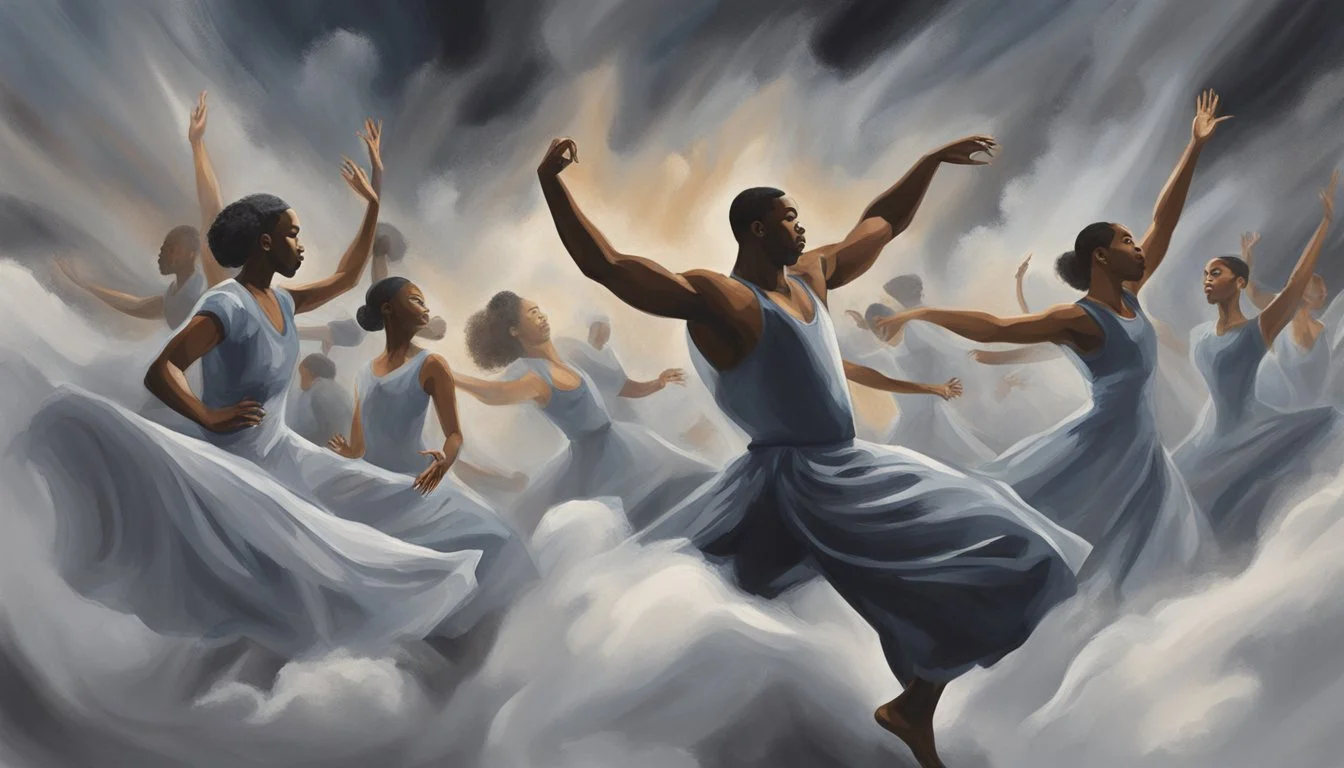Dancing Through Manic Depression: The Alvin Ailey Story
A Choreographer's Battle with Bipolar Disorder
Alvin Ailey revolutionized modern dance with his innovative choreography and powerful storytelling. As a trailblazing African American choreographer, he created works that celebrated Black culture and addressed social issues. Ailey's artistic genius was intertwined with his personal struggles, including bipolar disorder, which both challenged and fueled his creative process.
Ailey founded the Alvin Ailey American Dance Theater in 1958, breaking barriers by welcoming dancers of all races. His signature piece, "Revelations," drew from his childhood memories and became an enduring masterpiece that continues to captivate audiences worldwide. Despite his public success, Ailey grappled with his sexual orientation and mental health in private.
The choreographer's life was marked by periods of intense creativity and deep despair. His battle with manic depression influenced his artistry, infusing his works with raw emotion and profound depth. Ailey's legacy extends beyond dance, encompassing social justice, LGBTI rights, and mental health awareness.
Early Years of Alvin Ailey
Alvin Ailey's formative years were deeply shaped by his experiences in Texas during the Great Depression and segregation era. These early influences laid the foundation for his future artistic vision and social consciousness.
The Roots in Texas and Experience of Segregation
Alvin Ailey Jr. was born on January 5, 1931, in Rogers, Texas. He grew up in a segregated society, facing racial discrimination from an early age. Ailey's childhood was marked by poverty and the absence of his father.
His mother worked various jobs to support them, often leaving young Alvin in the care of others. These experiences exposed him to the harsh realities of racial inequality in the South.
Influence of Southern Culture and Gospel Music
The vibrant African American culture of rural Texas profoundly impacted Ailey's artistic sensibilities. He was particularly drawn to the emotional power of gospel music and the expressive movements in Black churches.
Ailey absorbed the rhythms, spirituals, and blues that would later inform his choreography. The juke joints and social gatherings he witnessed as a child provided a rich tapestry of movement and music that sparked his creative imagination.
Impact of the Great Depression and Hope for the Future
The economic hardships of the Great Depression added another layer of struggle to Ailey's early life. Despite these challenges, he found solace and inspiration in the resilience of his community.
The strength and dignity he observed in those around him fostered a sense of pride in his heritage. This period instilled in Ailey a desire to create art that celebrated African American culture and universal human experiences.
His early exposure to adversity and beauty would later fuel his passion for dance as a means of expression and social change.
Artistic Journey
Alvin Ailey's artistic journey transformed modern dance through innovative choreography and powerful performances. His work blended African American heritage with contemporary dance techniques, creating a unique and influential style.
Introduction to Dance and Lester Horton's Influence
Ailey discovered dance in his late teens after moving to Los Angeles. He studied with Lester Horton, a pioneering modern dance choreographer. Horton's technique, which emphasized flexibility and strength, became foundational to Ailey's style.
Horton's multicultural approach and social activism also shaped Ailey's artistic vision. Under Horton's mentorship, Ailey developed his skills as a dancer and choreographer. He performed with Horton's company and eventually took over as director after Horton's death in 1953.
Founding of Alvin Ailey American Dance Theater
In 1958, Ailey founded the Alvin Ailey American Dance Theater in New York City. The company's first performance featured Ailey's "Blues Suite," a work that drew from his Texas childhood experiences.
Ailey's goal was to create opportunities for African American dancers and to share the richness of black culture through dance. The company quickly gained recognition for its powerful performances and innovative choreography.
Evolution of Choreography and Key Performances
Ailey's choreography evolved to blend elements of modern dance, ballet, and jazz with African dance traditions. His most famous work, "Revelations" (1960), became a signature piece for the company. Set to spirituals and gospel music, it explored themes of struggle, faith, and triumph.
Other notable works included "Cry" (1971), a solo piece dedicated to black women, and "Night Creature" (1974), set to Duke Ellington's music. Ailey's choreography often addressed social issues and celebrated African American culture.
As a choreographer, Ailey created over 79 ballets. His works were characterized by emotional intensity, technical precision, and a deep connection to music and cultural heritage.
Signature Works
Alvin Ailey created several iconic pieces that defined his artistic vision and legacy. These works showcased his unique choreographic style, blending modern dance with African American cultural influences.
The Timeless Message of 'Revelations'
'Revelations' stands as Ailey's masterpiece, premiered in 1960 when he was just 29 years old. This powerful work explores African American spirituals, gospel, and blues music. It depicts the journey from struggle to redemption in three sections: 'Pilgrim of Sorrow', 'Take Me to the Water', and 'Move, Members, Move'.
The piece draws from Ailey's childhood memories in Texas, incorporating movements inspired by church services and baptisms. 'Revelations' has been performed countless times worldwide, becoming a cultural touchstone that resonates with audiences decades after its creation.
Its enduring appeal lies in its universal themes of hope, faith, and perseverance.
Emotional Depth in 'Cry' and 'Blues Suite'
'Cry', choreographed in 1971, is a solo piece dedicated to Ailey's mother. It portrays the struggles and strength of African American women. The dancer moves through a range of emotions, from anguish to joy, set to a soundtrack of popular and gospel music.
'Blues Suite', Ailey's first major work from 1958, depicts a night in a blues bar. It showcases his ability to blend ballet, modern dance, and jazz with African American social dance styles.
Both pieces demonstrate Ailey's talent for expressing complex emotions through movement, creating deeply personal yet universally relatable performances.
Expansion into Ballet and 'Night Creature'
Ailey's choreographic range extended beyond modern dance into ballet. 'Night Creature', set to Duke Ellington's jazz score, exemplifies this versatility. Created in 1974, it combines classical ballet techniques with Ailey's signature style.
The piece celebrates the vibrancy of nightlife, featuring sensual and playful movements. It demonstrates Ailey's ability to fuse different dance forms, creating a unique aesthetic that bridges classical and contemporary styles.
'Night Creature' highlights Ailey's innovation in expanding the boundaries of dance, incorporating elements from various traditions to create a distinctive artistic voice.
Cultural and Community Impact
Alvin Ailey's influence extended far beyond the stage, profoundly shaping American culture and dance. His work celebrated African American heritage while promoting unity and leadership in the dance world. The Alvin Ailey American Dance Theater's global tours spread this impact internationally.
Highlighting the African American Experience through Dance
Ailey's choreography brought African American stories and struggles to life through movement. His signature piece "Revelations" drew from spirituals, gospel, and blues to depict the Black experience in America.
The company's repertoire consistently featured works exploring African American history and culture. This representation on stage was groundbreaking, giving voice to underrepresented narratives.
Ailey's work educated audiences about Black culture while instilling pride in African American communities. His dances served as a powerful form of cultural preservation and expression.
Promotion of Unity and Leadership in the American Dance Community
Ailey broke racial barriers in the dance world, creating opportunities for dancers of color. The Alvin Ailey American Dance Theater became a beacon of diversity in a field often lacking representation.
He mentored countless dancers and choreographers, fostering a new generation of talent. The Ailey School, founded in 1969, continues this legacy by training dancers from various backgrounds.
Ailey's emphasis on accessibility made dance more inclusive. His company's free performances and educational programs brought dance to underserved communities.
Global Influence and International Tours
The AAADT's international tours spread Ailey's artistic vision worldwide. Performances in countries like South Africa during apartheid had profound cultural and political impacts.
Ailey's work resonated across cultures, demonstrating the universal power of dance. The company's global success helped elevate the status of American modern dance internationally.
Cultural exchange programs and workshops allowed the company to share techniques and philosophies with dancers worldwide. This global reach solidified Ailey's place as a cultural ambassador for American dance.
Educational Contributions
Alvin Ailey made significant contributions to dance education through his founding of The Ailey School and development of various programs to nurture new talent. His efforts expanded access to dance training and created opportunities for aspiring dancers from diverse backgrounds.
Founding of The Ailey School
Alvin Ailey established The Ailey School in 1969 as a hub for dance education. The school offered professional training in a variety of dance techniques, including ballet, modern, jazz, and West African. Ailey believed in making dance accessible to all, regardless of financial means or background.
The school implemented scholarship programs and community outreach initiatives to support talented students who may not otherwise have access to formal dance training. Over the years, The Ailey School has produced numerous accomplished dancers and choreographers who have gone on to successful careers in the field.
Education Programs and Developing New Talent
Ailey's commitment to education extended beyond The Ailey School. He implemented several programs aimed at developing new talent and fostering a love for dance in young people. These included:
• AileyCamp: A summer program for at-risk youth that combines dance training with personal development workshops • Ailey Extension: Classes open to the public, allowing dancers of all levels to experience the Ailey style • Ailey II: A junior company that provides performance opportunities for emerging dancers
These programs not only taught dance techniques but also instilled discipline, self-confidence, and creativity in participants. Ailey's educational initiatives have had a lasting impact on the dance community, continuing to inspire and train new generations of dancers long after his passing.
Legacy and Continuation
Alvin Ailey's impact on modern dance endures through his company's continued excellence and expansion. His vision lives on through artistic leadership, a growing repertoire, and prestigious recognition.
Artistic Direction from Judith Jamison to Robert Battle
Judith Jamison, Ailey's muse and principal dancer, took the helm as Artistic Director in 1989. She led the company for 21 years, maintaining Ailey's artistic vision while propelling it to new heights. Under her guidance, the Alvin Ailey American Dance Theater became one of the most successful modern dance companies globally.
In 2011, Robert Battle assumed the role of Artistic Director. Battle, hand-picked by Jamison, brought fresh perspectives while honoring Ailey's legacy. His leadership has introduced innovative works and collaborations, ensuring the company remains at the forefront of contemporary dance.
Expanding Repertoire and Maintaining Ailey's Vision
The company's repertoire has grown significantly since Ailey's time, incorporating works from diverse choreographers. New pieces explore contemporary themes while staying true to Ailey's mission of celebrating African American culture through dance.
Signature works like "Revelations" remain central to the company's identity. This masterpiece, created by Ailey in 1960, continues to captivate audiences worldwide. It stands as the most-viewed modern dance piece globally, a testament to its enduring power and relevance.
The Ailey School and Ailey II, the junior company, continue to nurture new talent and spread Ailey's artistic vision to younger generations.
Recognition and Kennedy Center Honors
Alvin Ailey American Dance Theater's contributions to the arts have earned numerous accolades. In 1988, the company received a prestigious Kennedy Center Honor, recognizing its significant impact on American culture.
Ailey himself was posthumously awarded the Presidential Medal of Freedom in 2014, the highest civilian honor in the United States. This recognition highlighted his profound influence on dance and his role in breaking racial barriers in the arts.
The company's performances at high-profile events, including presidential inaugurations, further cement its status as a national treasure. Its global tours continue to spread Ailey's message of hope and unity through dance.
Influence on the Wider World
Alvin Ailey's impact extended far beyond the realm of dance, inspiring artists, activists, and individuals worldwide. His work challenged societal norms and celebrated African American culture, leaving an indelible mark on the arts and society at large.
Inspiration beyond the Dance World
Ailey's choreography and performances resonated with people from all walks of life. His ability to convey powerful emotions through movement inspired painters, sculptors, and musicians to explore new forms of expression. Writers and poets found inspiration in Ailey's storytelling, incorporating his themes of struggle and triumph into their works.
Ailey's success as an African American dancer and choreographer in a predominantly white field encouraged aspiring artists of color to pursue their dreams. His company's international tours exposed global audiences to African American culture, fostering cross-cultural understanding and appreciation.
Ailey's Impact on Art, Resonance, and Beauty
Alvin Ailey's work redefined notions of beauty in dance, challenging traditional aesthetics and celebrating diverse body types and skin tones. His choreography emphasized strength, grace, and emotional depth, showcasing the power of the human body to communicate complex ideas.
Ailey's resilience in the face of personal struggles and societal barriers became a source of inspiration for many. His openness about his experiences with manic depression helped destigmatize mental health issues in the arts community.
The Alvin Ailey American Dance Theater continues to carry his legacy, promoting diversity and inclusion in the dance world. Ailey's influence can be seen in contemporary dance, theater, and even popular culture, cementing his status as a transformative figure in American art.
Personal Struggles and Triumphs
Alvin Ailey faced significant personal challenges throughout his life. He battled mental health issues and a devastating illness while continuing to create groundbreaking dance works.
Battling Manic Depression and Personal Challenges
Ailey struggled with manic depression, which affected both his personal life and artistic career. The condition caused extreme mood swings, from intense creative highs to debilitating lows.
During manic phases, Ailey would work feverishly on new choreography. These periods of heightened productivity led to some of his most innovative pieces.
The depressive episodes, however, left him unable to work for extended periods. Ailey sought treatment but continued to face recurring bouts of depression.
Despite these challenges, he persevered in developing his dance company and choreographing new works. His determination to create art in the face of mental illness became an inspiration to many.
Courage and Determination in the Face of AIDS
In the 1980s, Ailey was diagnosed with HIV/AIDS. He kept his diagnosis private, fearing stigma could harm his dance company.
Ailey continued to choreograph and lead his company while battling the illness. His work during this time reflected themes of struggle and resilience.
As his health declined, Ailey focused on securing the future of his dance company. He appointed Judith Jamison as his successor to ensure his artistic legacy would continue.
Ailey demonstrated remarkable courage in his final years. He maintained an active role in the company until shortly before his death in 1989 at age 58.
Documenting the Icon
Alvin Ailey's life and artistry have been captured through various mediums, preserving his legacy for future generations. These works offer insights into his groundbreaking contributions to American dance and his personal struggles.
Biographies and Memoirs on Alvin Ailey's Life and Work
Jennifer Dunning's biography "Alvin Ailey: A Life in Dance" stands as a definitive account of the choreographer's journey. Published in 1996, it delves into Ailey's Texas roots, his move to New York City, and the formation of his dance company.
Other notable works include "Dancing Revelations" by Thomas DeFrantz and "My Story, My Dance" by Lesa Cline-Ransome. These books explore Ailey's artistic vision and his impact on the dance world.
Personal memoirs from dancers who worked with Ailey provide intimate glimpses into his creative process and leadership style.
A Life in Dance: The Role of Documentaries and Interviews
Several documentaries have brought Ailey's story to life on screen. "Ailey," directed by Jamila Wignot, premiered in 2021 and features archival footage and interviews with those who knew him.
Television appearances and recorded interviews offer viewers direct access to Ailey's thoughts and personality. These include his 1988 appearance on "The South Bank Show" and various news interviews throughout his career.
The Alvin Ailey American Dance Theater's official archives contain a wealth of video material, preserving performances and behind-the-scenes moments for researchers and dance enthusiasts.
Conclusion
Alvin Ailey's journey through manic depression and artistic brilliance left an indelible mark on the dance world. His company, the Alvin Ailey American Dance Theater, continues to inspire audiences globally.
Ailey's choreography, especially his masterpiece "Revelations," remains a powerful expression of the African American experience. His work transcended racial barriers and brought modern dance to new heights of popularity and acclaim.
The legacy of Alvin Ailey extends far beyond his choreography. His inclusive approach to casting and his commitment to showcasing diverse talent helped reshape the landscape of American dance.
Despite his inner struggles, Ailey's artistic vision and determination propelled him to create works that continue to resonate with audiences today. His life serves as a testament to the transformative power of art and perseverance.
The Alvin Ailey American Dance Theater stands as a living tribute to its founder's enduring impact. It continues to push boundaries, nurture new talent, and celebrate the human spirit through dance.











